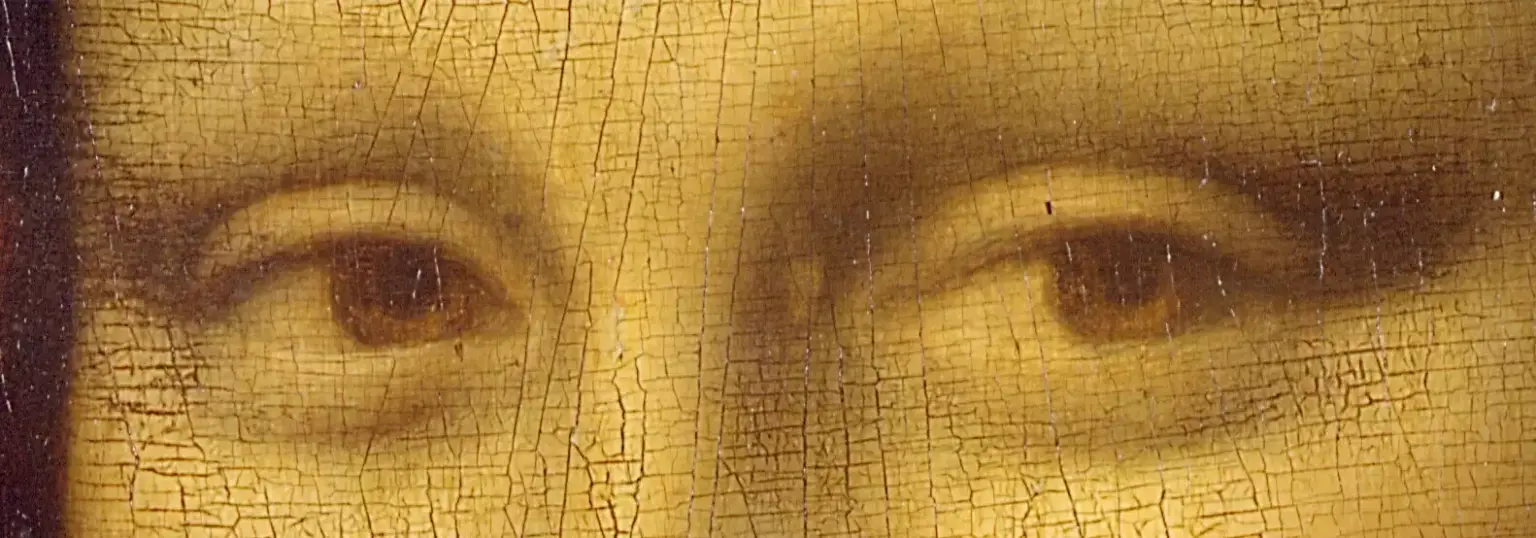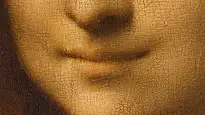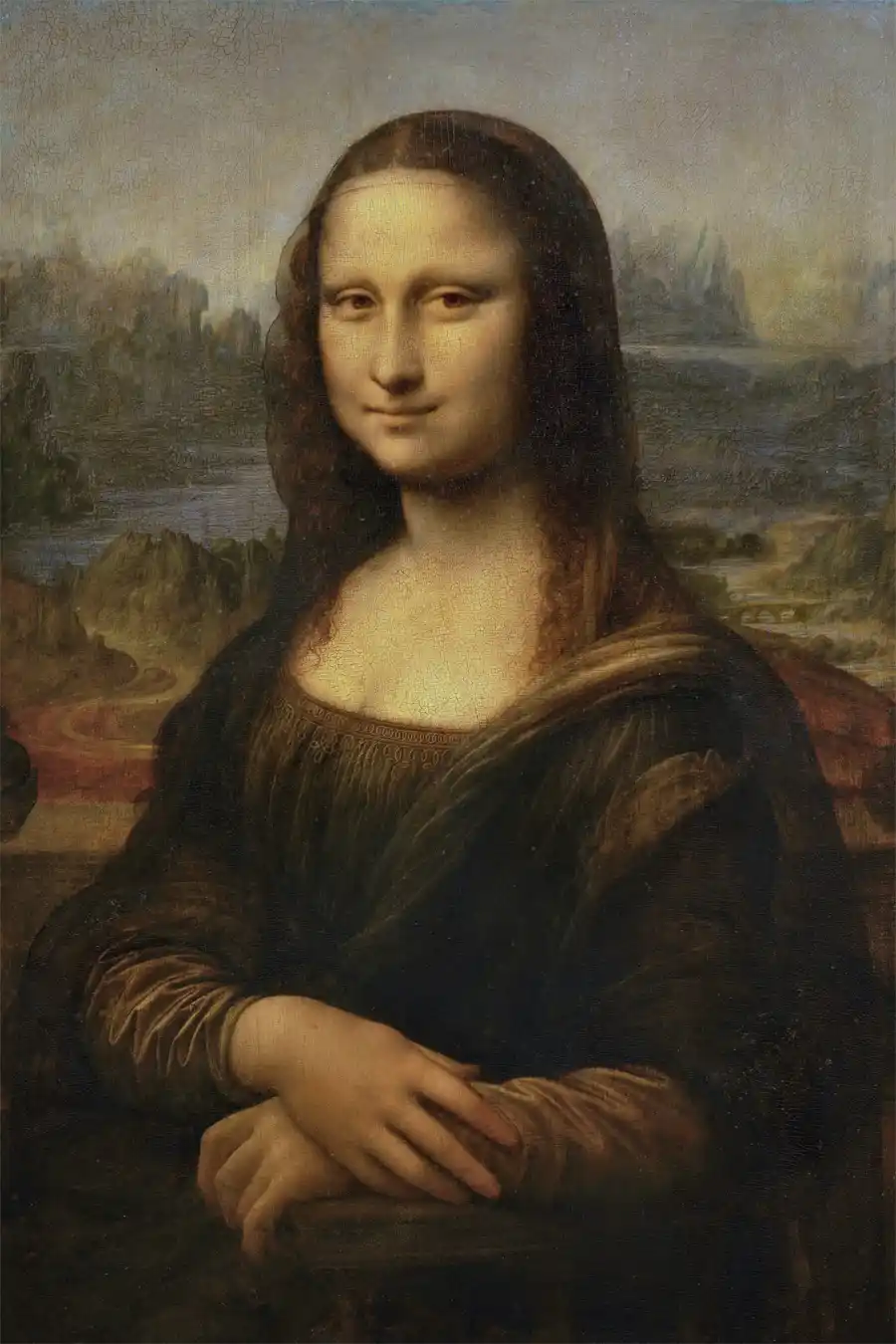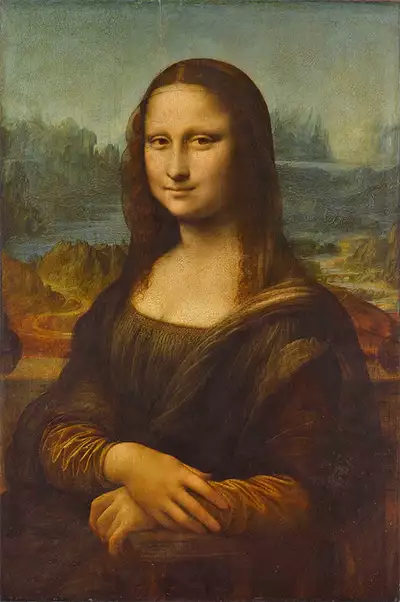Analysis of the Work: The Mona Lisa
Author: Leonardo da Vinci
Original Title: La Gioconda (Italian: “Monna Lisa”)
Date of Creation: Between 1503 and 1519
Style: Italian Renaissance
Support: Poplar panel
Technique: Oil
Dimensions: 77 cm × 53 cm
Current Location: Louvre Museum, Paris, France
Introduction

The portrait depicts a woman with a serene and enigmatic expression, set against a landscape background that seems to stretch on infinitely. This painting stands out not only for its technical quality but also for the mysteries that surround it: the identity of the model, the meaning of her smile, and the technical innovations employed by da Vinci have been topics of debate for centuries.
In this analysis, we will explore the most important details of “The Mona Lisa,” from the technical aspects of its creation to its iconographic meaning. We will also address the historical context and the work’s impact on art history, as well as the cultural aspects that have elevated this painting to the status of a global icon.
Pictorial Commentary
Technical Elements
“The Mona Lisa” is a pictorial work executed on a poplar panel, a support widely used during the Renaissance, especially in Italy. The material offers a stable and durable surface, suitable for the detailed work characteristic of Leonardo da Vinci. The technique employed is oil, which gives the painting a smooth texture and allows for a glazing effect that adds depth and realism to the work.
The use of oil was particularly advantageous for Leonardo, as it allowed him to apply thin layers of paint to create subtle transitions between light and shadow. This approach, known as sfumato, is one of the most innovative aspects of the work. Sfumato eliminates defined contours and allows colors and tones to merge smoothly, giving an ethereal and three-dimensional quality to the model’s face.
Regarding the brushwork, Leonardo used extremely fine and precise brushstrokes, almost imperceptible to the naked eye. This not only contributed to the naturalistic effect but also demonstrates the artist’s perfectionism and his dedication to the study of human anatomy and optics. Moreover, it is important to note that there are no visible signs of heavy or rough brushstrokes, which suggests a meticulous application and impressive technical control.

Detail of the Mona Lisa’s face showing the sfumato technique.
Another relevant technical aspect is the preparation of the panel. Before painting, Leonardo applied a plaster base (gesso), which allowed for a smooth and uniform finish. This was common in his time and provided an optimal surface for working with oil. Despite the centuries that have passed, the painting has managed to remain relatively well preserved, although the wooden support has suffered some deformations due to humidity and the passage of time.
Finally, it is important to note that the work is neither signed nor dated, a common practice during the Renaissance. However, historical records and technical analysis have confirmed Leonardo da Vinci’s authorship and place the start of the work around 1503, although it is known that Leonardo continued working on it intermittently until his death in 1519.
Formal Elements
Regarding the formal elements of “The Mona Lisa,” the composition stands out for its pyramidal structure, a typical characteristic of the Renaissance. The figure of the model is positioned at the center of the work, creating a visual balance that immediately draws the viewer’s attention to her face and enigmatic smile. The pyramid is formed by the model’s arms and hands, which act as the base, while the head becomes the upper vertex. This arrangement confers stability and harmony to the work.
The main lines that structure the composition are soft and curvilinear, reinforcing the sense of serenity and calm emanating from the figure. Although there are no marked straight lines, the contours of the model are perfectly defined within the framework of the visual pyramid, demonstrating Leonardo’s technical mastery in balancing the geometric with the organic.
The landscape background, although seemingly secondary, plays a crucial role in the composition. The horizon line is slightly lower on the right side, which introduces a subtle asymmetry that increases the dynamism of the painting without disrupting its overall balance. This landscape, composed of mountains, rivers, and winding paths, stretches into infinity, providing a strong contrast with the human figure in the foreground.
In the analysis of proportions, Leonardo used the classical canon of beauty, based on mathematical and geometric proportions. This not only underscores his interest in human anatomy but also his fascination with the relationship between art and science. The three-quarter pose of the model allows for a more natural and volumetric representation, a significant advancement compared to the more rigid frontal portraits of earlier periods.
Additionally, it is noteworthy that Leonardo employed a system of diagonal lines to guide the viewer’s gaze. These diagonals are found primarily in the contours of the model’s dress and arms, directing attention toward her face. At the same time, the curved lines in the background reinforce the sense of movement and continuity, perfectly integrating the figure with its surroundings.
Color
The use of color in “The Mona Lisa” is a key element that contributes to the painting’s unique and captivating atmosphere. Leonardo da Vinci employed a warm and moderate color palette, dominated by earthy tones, ochres, browns, and dark greens. These colors convey a sense of warmth, serenity, and timelessness, characteristics that have turned this portrait into a universal icon.
In the treatment of color, a perfect balance between light and shadow is observed, achieved through the technique of sfumato. This approach allows the tones to blend smoothly and gradually, eliminating defined contours and providing a realistic three-dimensionality to the model’s figure. Sfumato is also evident in the delicate transitions on the model’s face, where the shadows on the cheeks, nose, and eyes merge with the lighter tones of her skin to create a natural volumetric effect.
The choice of cool and muted colors in the background contrasts with the warm tones of the main figure. This chromatic interaction enhances the presence of the model, while the landscape background dissolves gently into the distance. The technique of aerial perspective, which uses the gradation of tones to represent depth, further reinforces this effect. The desaturated blues and greens in the mountains and sky suggest a vast and mysterious space that seems to extend beyond the boundaries of the painting.
Light and color are closely related in this work, and Leonardo used subtly illuminated tones to guide the viewer’s attention to the most important features of the model. The lighter tones are concentrated on her face and hands, while the darker tones of her dress and hair frame her figure, creating a contrast that directs the gaze toward the center of the composition.
It is important to mention that the original colors of the work have undergone alterations over time due to the natural aging of the materials and the oxidation of the varnish layers. Despite this, the chromatic harmony and Leonardo’s technical mastery remain evident and continue to fascinate viewers more than 500 years after its creation.
Treatment of Light
The treatment of light in “The Mona Lisa” is one of the most outstanding aspects of the work and reflects Leonardo da Vinci’s deep understanding of optics and illumination. Leonardo uses a diffuse and uniform light that envelops the model, eliminating harsh shadows and creating a soft, natural atmosphere. This lighting contributes to the three-dimensional effect of the figure and establishes a harmonious balance between the model and the background.
The light appears to emanate from a soft and generalized source, allowing the volumes of the face and hands to be modeled with precision. Through the technique of sfumato, Leonardo achieves imperceptible transitions between areas of light and shadow, especially on the model’s face. This approach eliminates rigid contours, making the forms seem to emerge smoothly from the gloom, thereby adding mystery and depth to the portrait.
An interesting detail is how the light is focused on the key areas of the composition: the face and the hands. These parts of the figure are illuminated more intensely, directing the viewer’s attention to the most expressive elements of the work. In contrast, the dress and hair remain in a darker shadow, acting as a frame that reinforces the main focus.
Another notable aspect is the symbolic use of light. In the Renaissance, light often symbolized knowledge, divinity, or inner life. In “The Mona Lisa,” the soft illumination that envelops the model could be interpreted as an expression of her mystery and serenity, highlighting her enigmatic character.
In summary, the light in “The Mona Lisa” not only serves a technical function to model the figure but also contributes significantly to the overall atmosphere and symbolism of the work. Leonardo’s mastery in the use of light is a testament to his ability to combine art and science in an exceptional manner.
Space
The handling of space in “The Mona Lisa” is another of Leonardo da Vinci’s great technical achievements. The work employs a masterful combination of linear perspective and aerial perspective to create a sense of depth and three-dimensionality that was revolutionary for its time. The figure of the model is situated in the foreground, standing out clearly against the landscape background, which gradually fades into the distance.
In linear perspective, one can observe how the lines of the landscape implicitly converge toward a vanishing point, creating a sense of order and structure in the composition. At the same time, aerial perspective is used to represent the atmosphere, giving the background a softer and less detailed appearance. The mountains, rivers, and winding paths gradually blur through a transition of cooler, desaturated colors, suggesting a great distance between the background and the main figure.
The superposition of planes is another resource that Leonardo employs masterfully. The model’s body is clearly defined and occupies the central space, while the background landscape seems to extend indefinitely. This contrast between the near and far planes helps to emphasize the figure’s volume and reinforces her presence in the pictorial space.

It is also relevant to analyze how Leonardo connects the figure with the background. Although the model and the landscape are clearly distinguishable, there is a tonal and luminous continuity that subtly unites them. This suggests that the figure is not isolated from the world around her, but rather forms part of an integrated and harmonious space.
The three-quarter pose of the model also contributes to the treatment of space. This position allows Leonardo to represent both the frontal view of the face and the depth of the body, adding dynamism to the figure. The slight inclination of the shoulders and the twist of the torso reinforce the three-dimensionality and give the impression that the model occupies a real space, not just a flat surface.
In conclusion, the treatment of space in “The Mona Lisa” combines innovative techniques and a deep understanding of optics and human perception. This handling of space not only enhances the central figure but also creates a sense of harmony and continuity that has fascinated viewers for centuries.
Iconographic Analysis
The iconographic analysis of “The Mona Lisa” leads us to explore not only the identity of the model but also the possible symbolic and cultural meanings associated with this work. Traditionally, the woman portrayed has been identified as Lisa Gherardini, the wife of a Florentine merchant named Francesco del Giocondo, hence the painting’s alternative title: La Gioconda. However, this identification, although widely accepted, has not been definitively confirmed, which adds an aura of mystery to the portrait.
One of the most discussed aspects of the work is the enigmatic smile of the model, which seems to change depending on the angle and distance from which it is observed. This ambiguity has given rise to countless interpretations: some believe it symbolizes serenity and balance, while others see it as a reflection of the complexity of human emotion. Leonardo achieved this effect through sfumato, which allows the lips and cheeks to merge softly with the shadows, avoiding defined contours.
The landscape background also plays an important role in the iconographic analysis. The mountains, rivers, and winding paths could symbolize the connection between humanity and nature, a central idea in Renaissance thought. The absence of an urban or architectural context in the landscape reinforces the idea of a timeless and universal space, elevating the model to an almost metaphysical plane.

Detail of the famous smile of the Mona Lisa, an example of the sfumato technique.
On a symbolic level, the model’s pose also carries significant connotations. The three-quarter position, with crossed hands, projects a sense of modesty and refinement, qualities associated with Renaissance ideals of femininity. The hands, carefully detailed, not only display Leonardo’s technical prowess but could also symbolize calm and self-control.
In cultural terms, “The Mona Lisa” also reflects the growing Renaissance interest in the individual and the portrait as a means to capture a person’s essence. Unlike the more static portraits of earlier periods, this portrait seems to capture a fleeting moment, as if the model were alive and aware of the viewer’s presence.
Finally, it is important to consider the historical and iconographic impact of the work itself. “The Mona Lisa” has become a universal symbol of mystery, beauty, and artistic perfection. Its presence in the Louvre Museum has transformed it into one of the most recognizable pieces of Western art, and its influence extends to all areas of popular culture.

Mona Lisa – Leonardo da Vinci
The Mona Lisa is an iconic portrait that embodies the essence of the Renaissance period. Painted by Leonardo da Vinci, this masterpiece showcases his exceptional skill in portraiture and the innovative use of sfumato, a technique that creates soft transitions between colours and tones. The subject, a woman with an enigmatic expression, captivates viewers with her slight smile and direct gaze, e…

